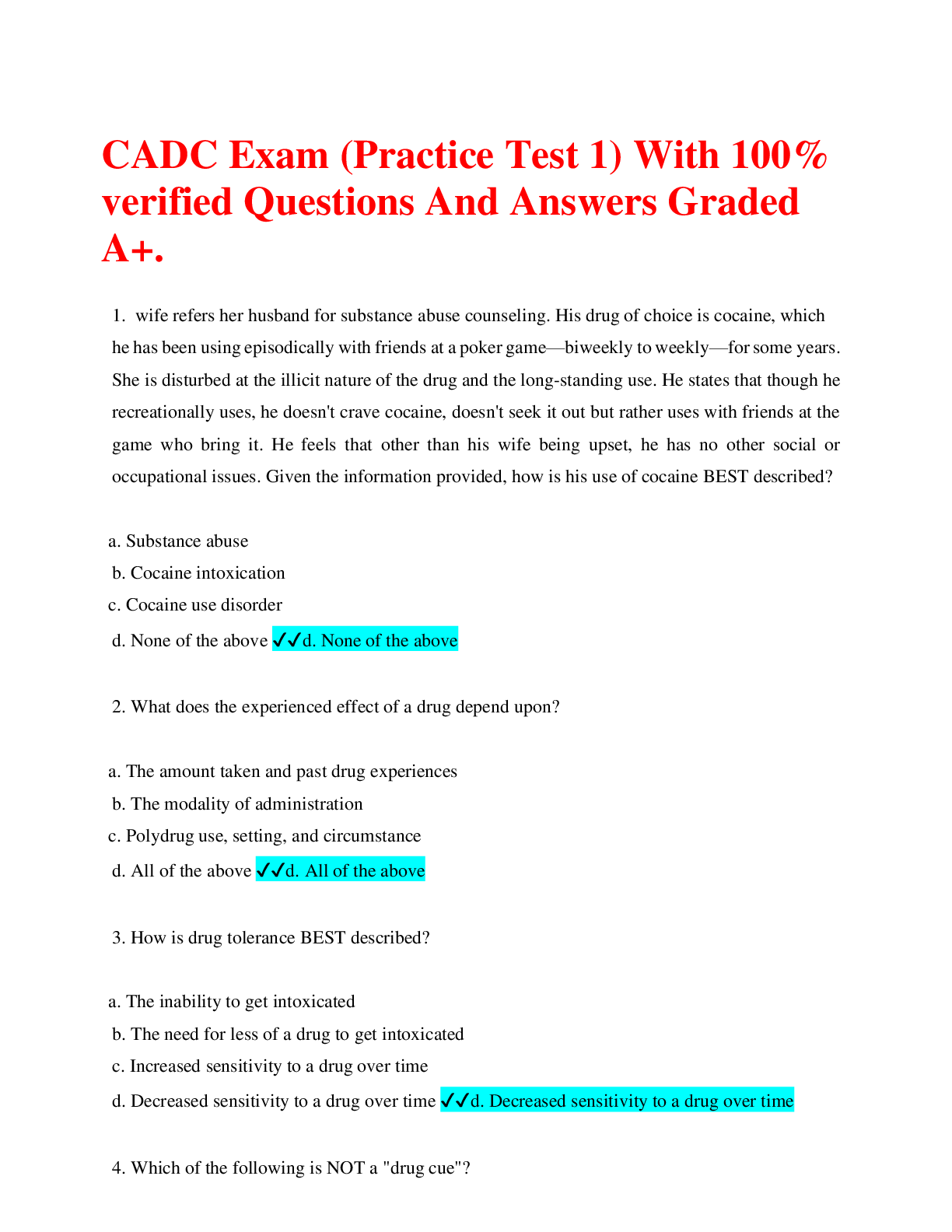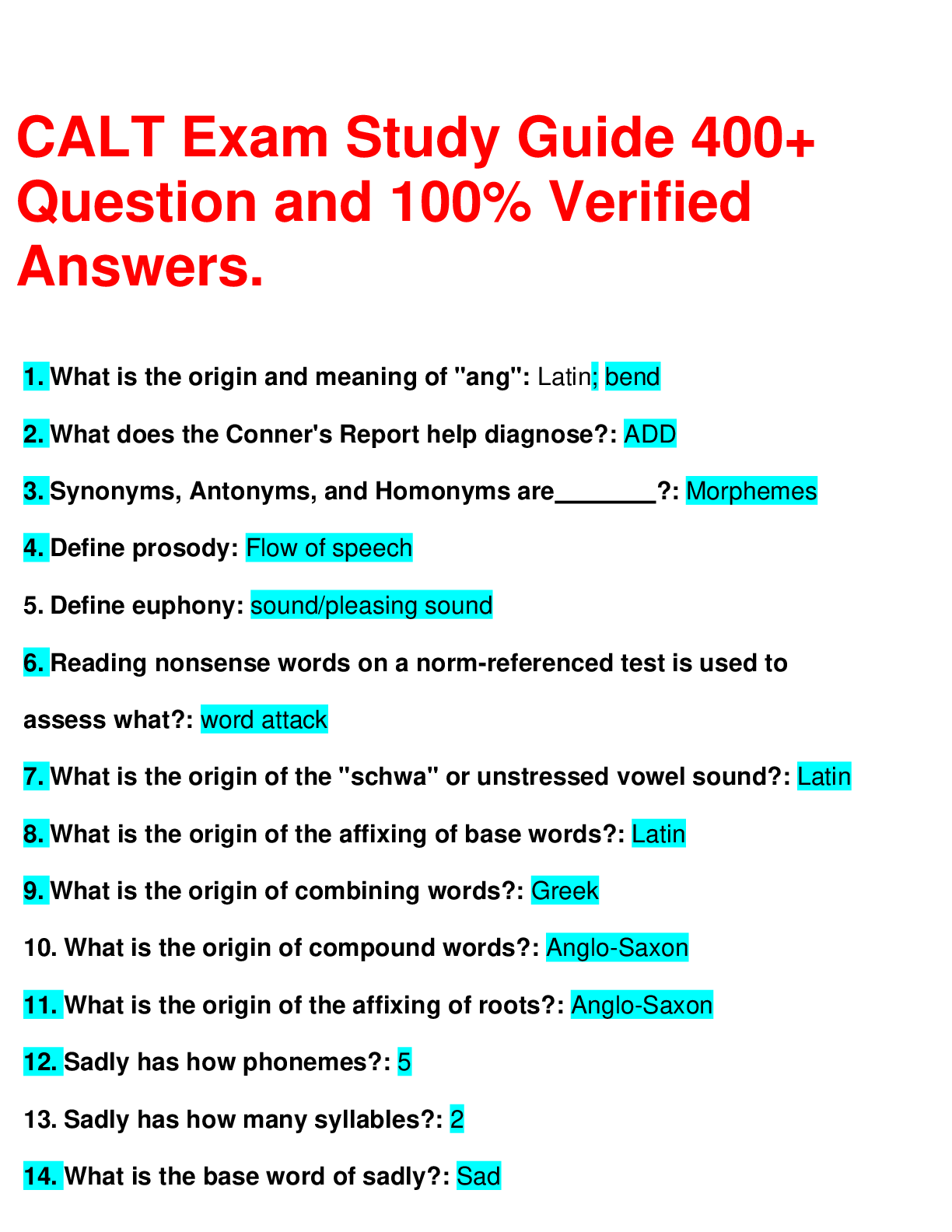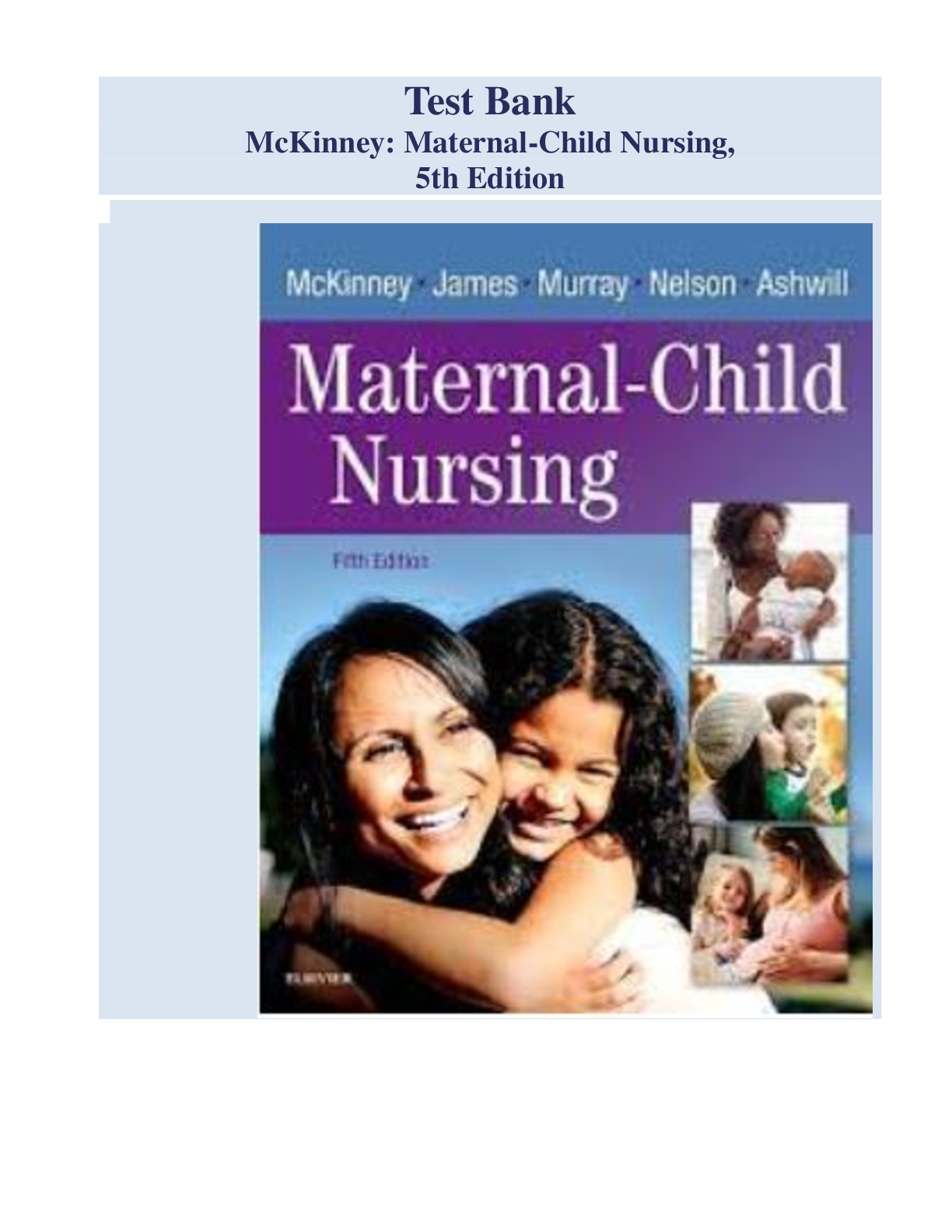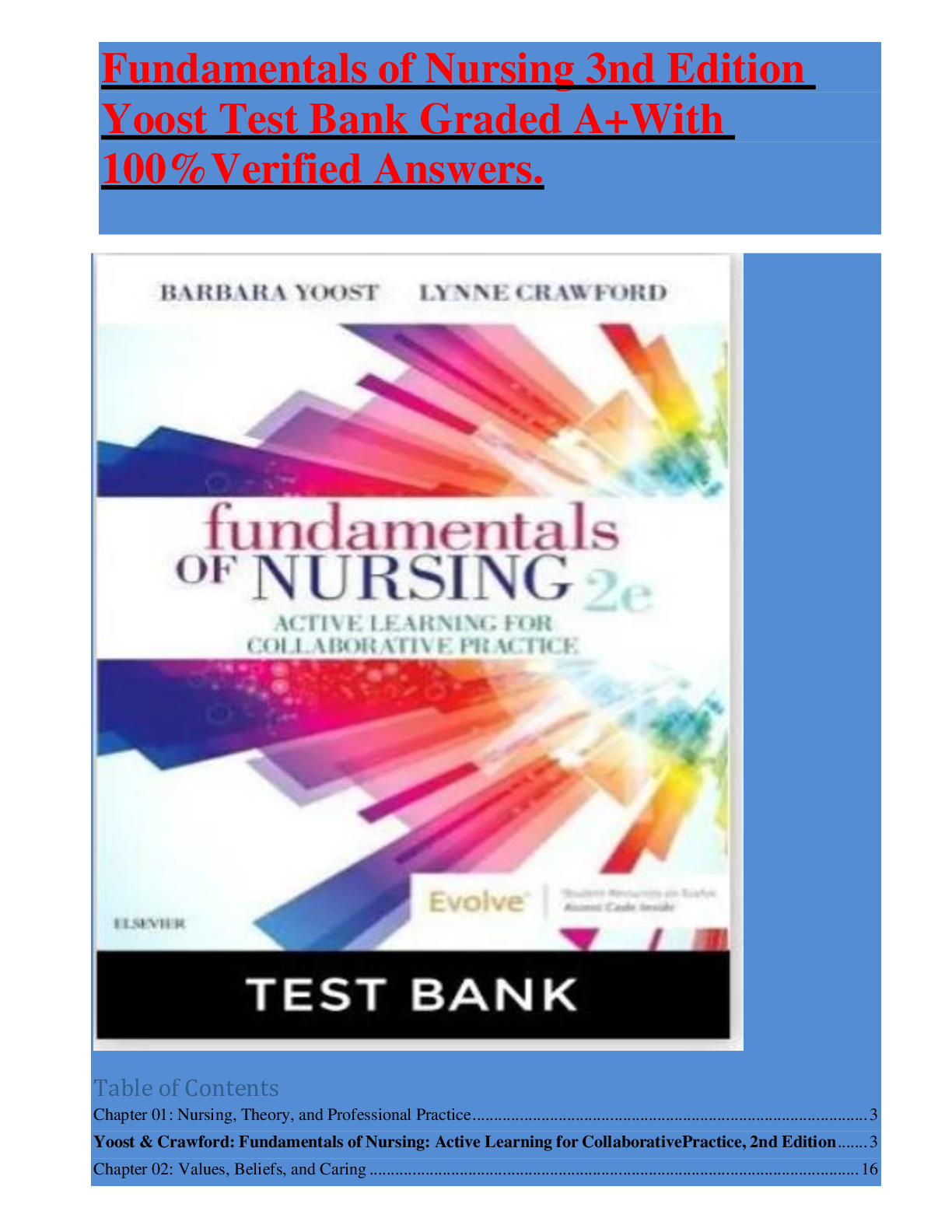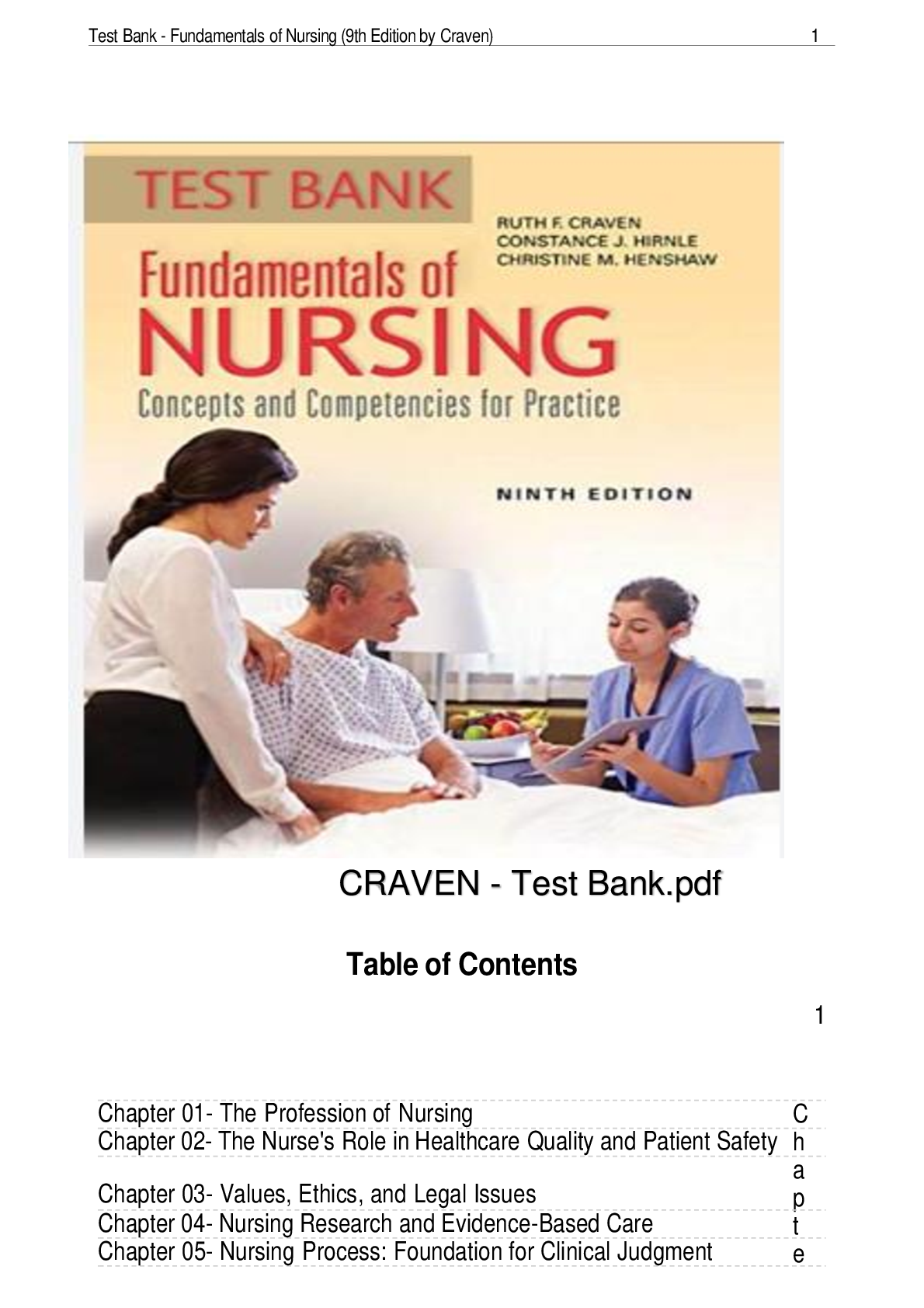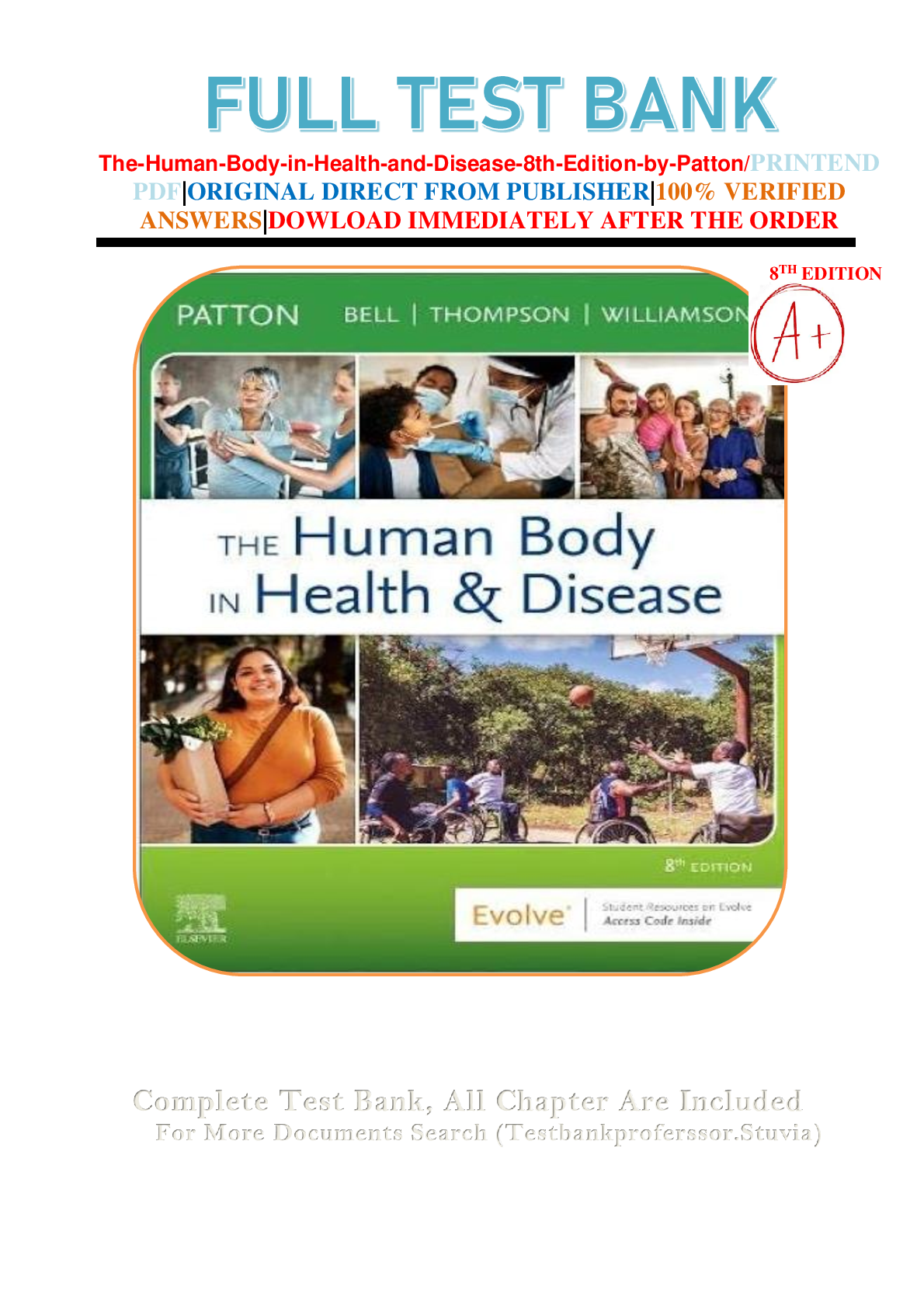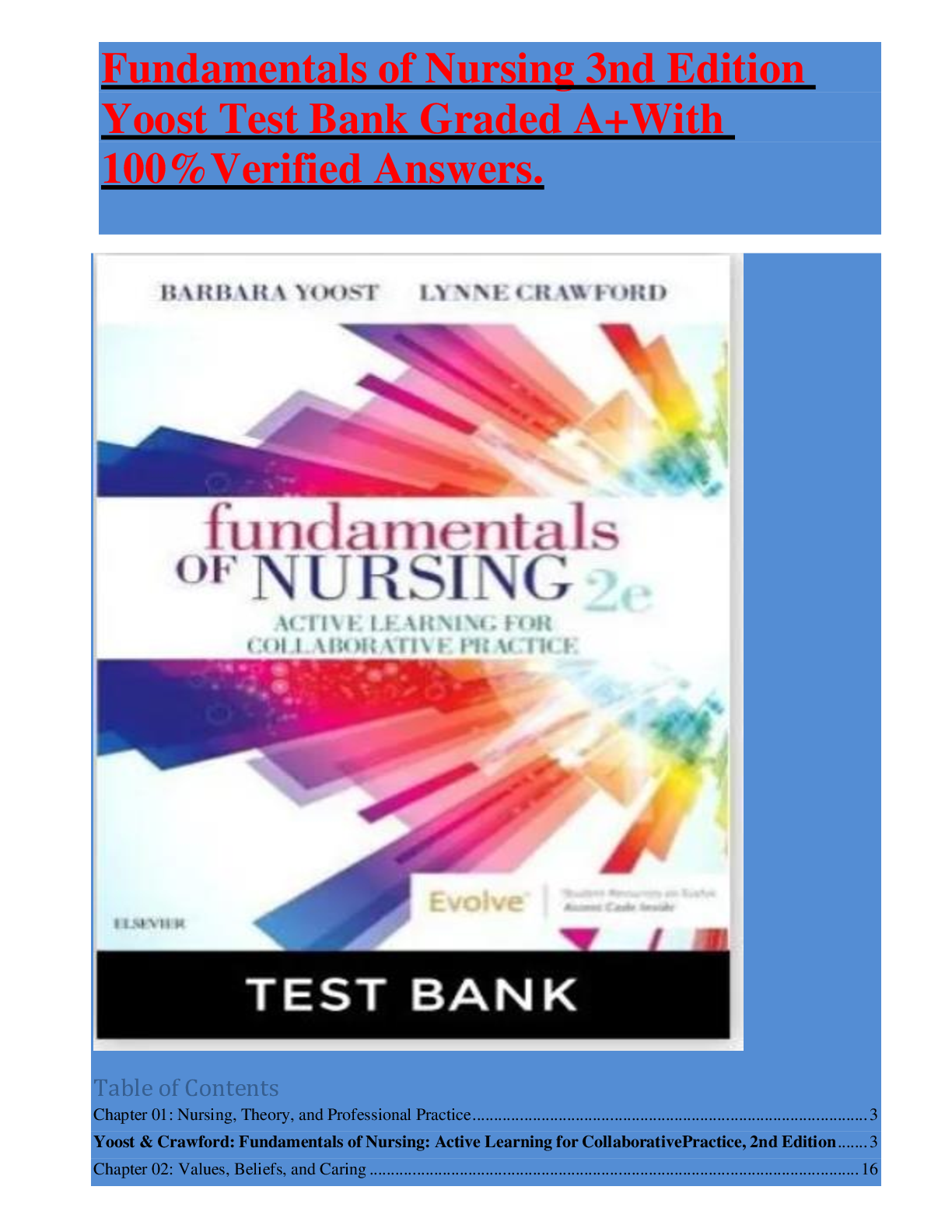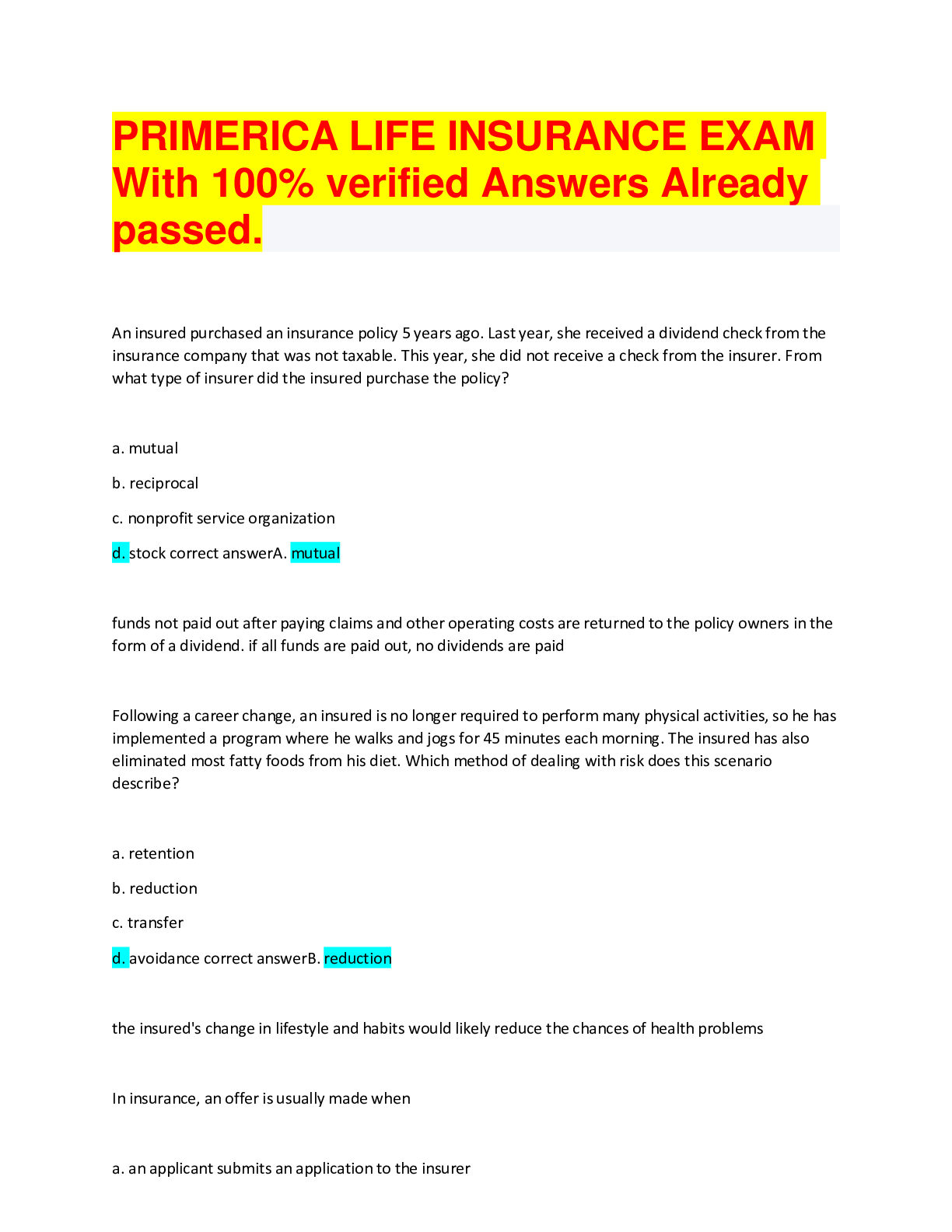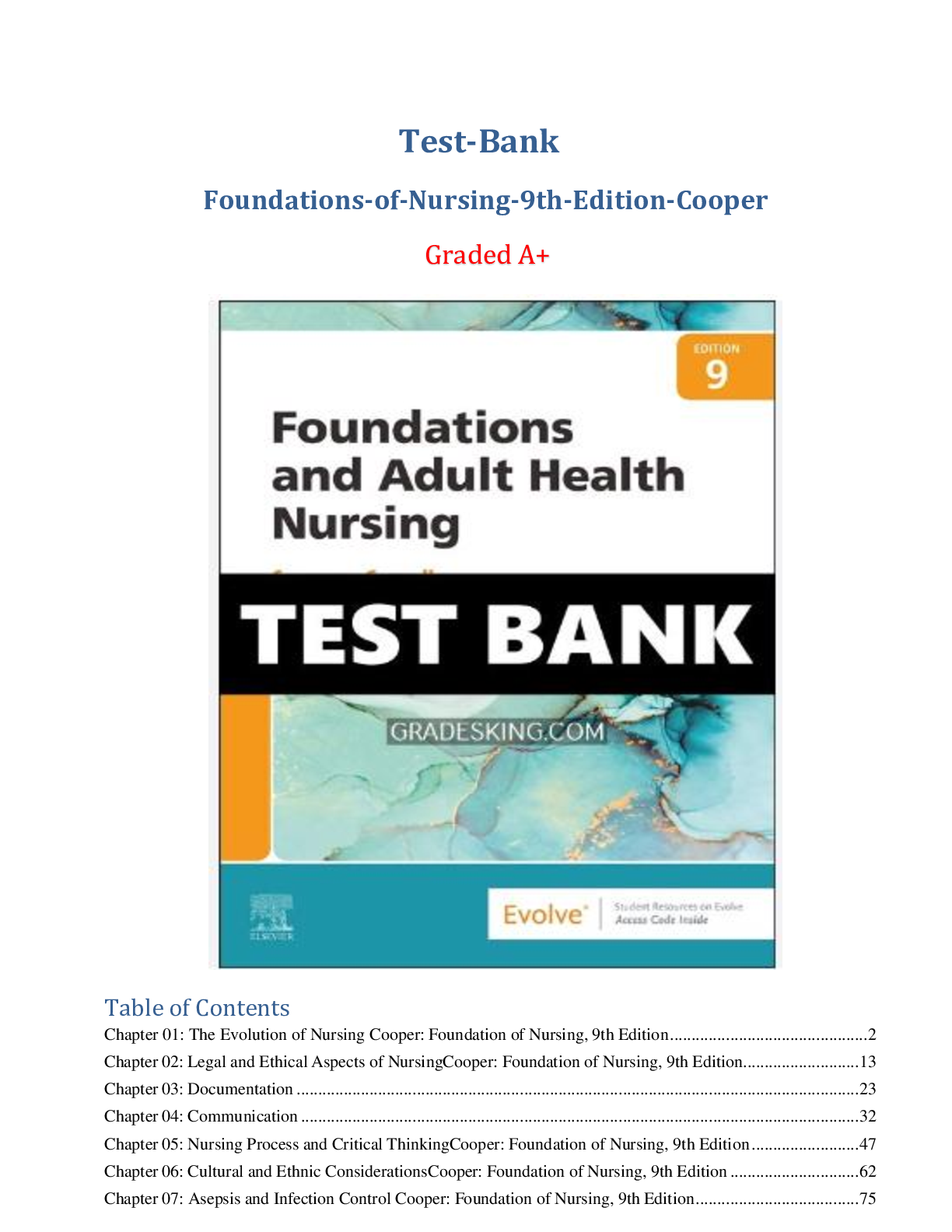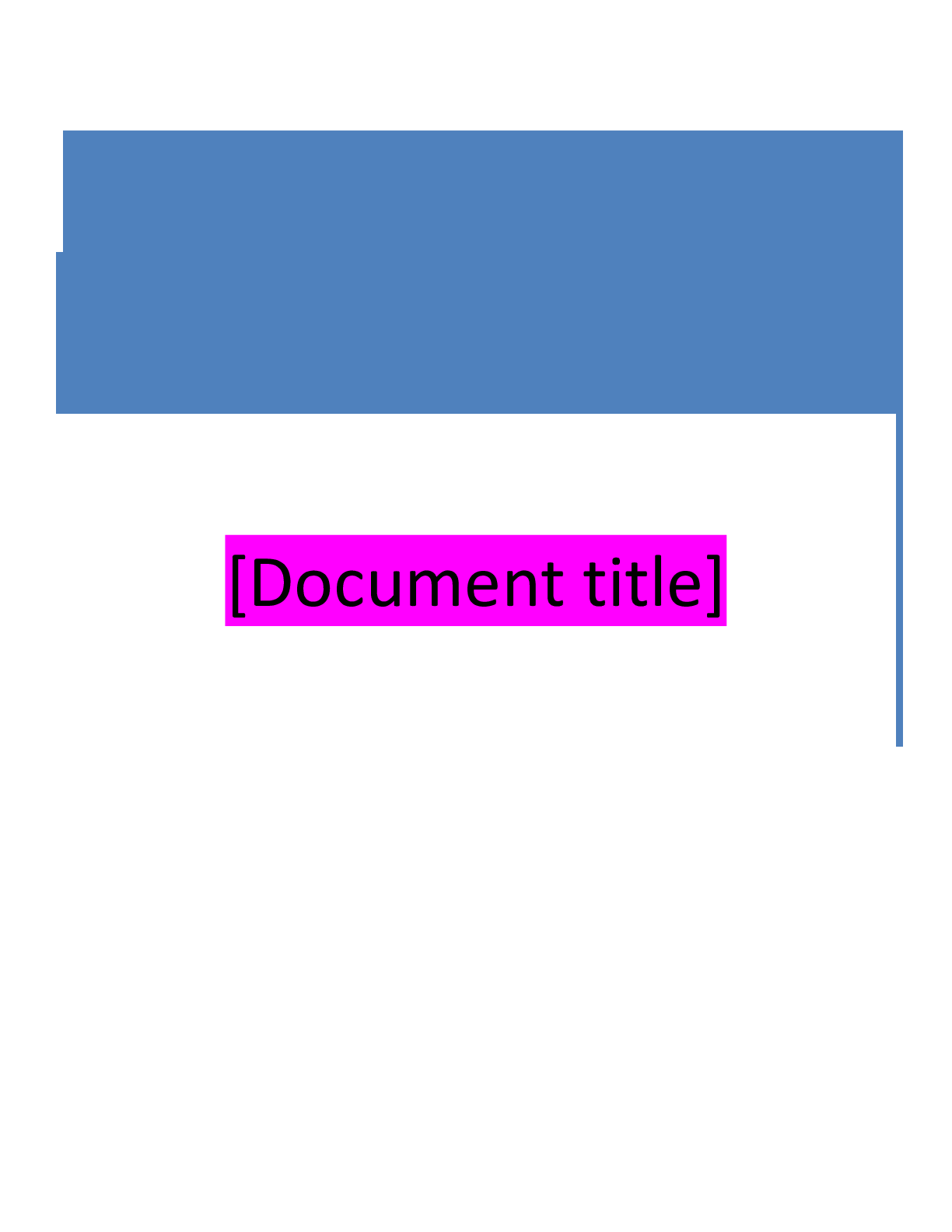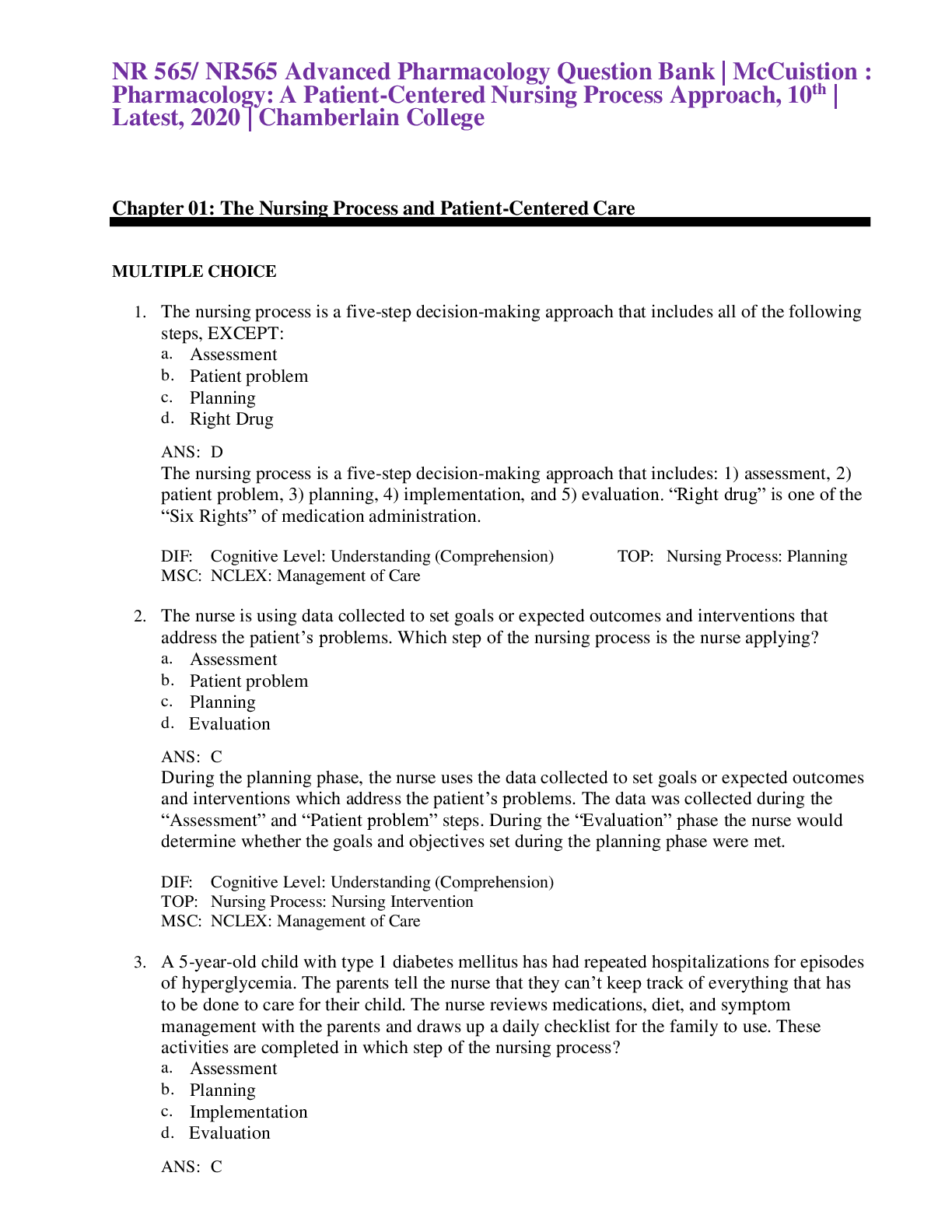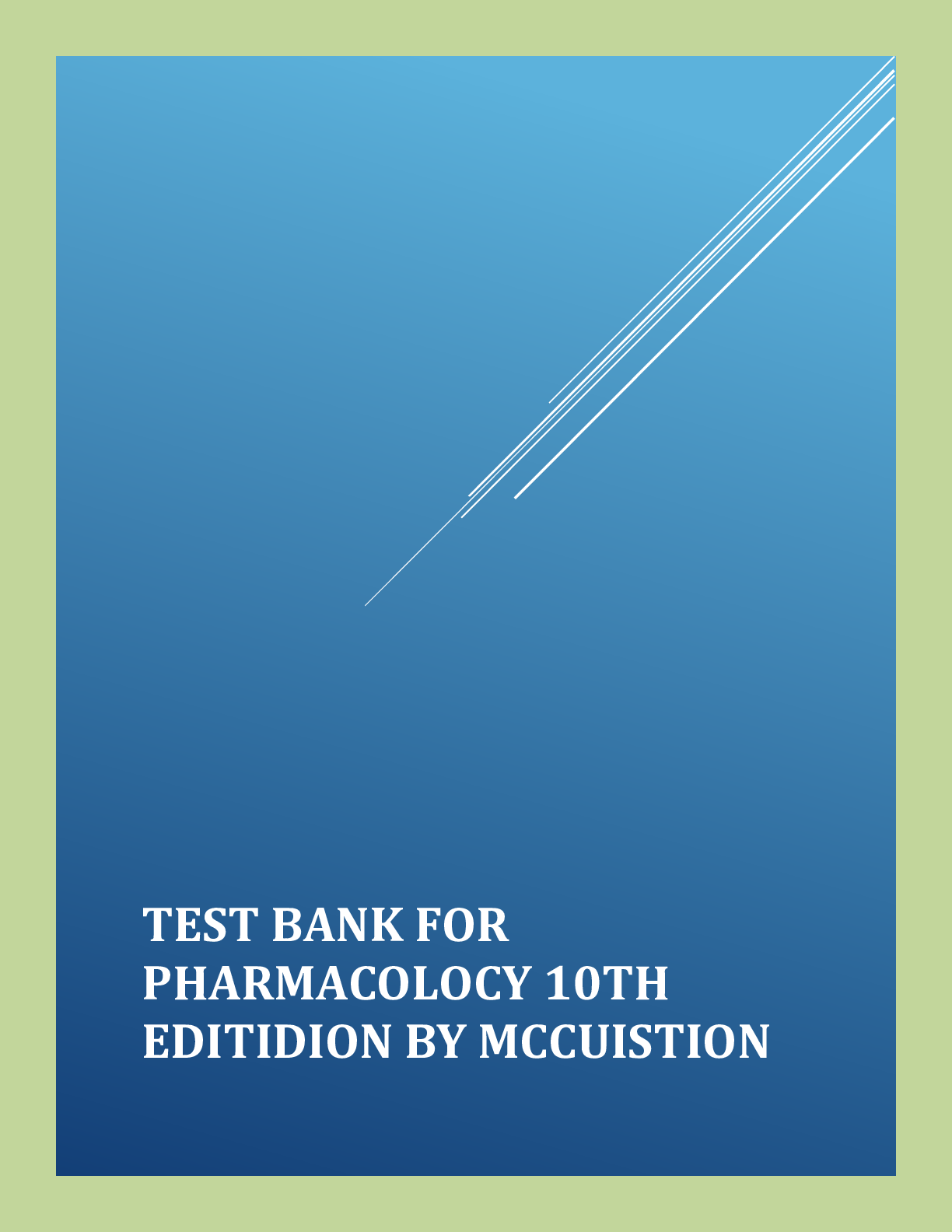*NURSING > EXAM > Test Pharmacology A Patient-Centered Nursing Process Approach, 11th Edition by Linda E. McCuistion C (All)
Test Pharmacology A Patient-Centered Nursing Process Approach, 11th Edition by Linda E. McCuistion Chapter 1-58
Document Content and Description Below
Test Bank Pharmacology A Patient-Centered Nursing Process Approach, 11th Edition by Linda E. McCuistion Chapter 1-58 Table of Contents Chapter 01:... The Nursing Process and Patient-Centered Care 3 Chapter 02: Drug Development and Ethical Considerations 9 Chapter 03: Pharmacokinetics and Pharmacodynamics 17 Chapter 04: Pharmacogenetics 30 Chapter 05: Complementary and Alternative Therapies 33 Chapter 06: Pediatric Considerations 38 Chapter 07: Geriatric Considerations 45 Chapter 08: Drugs in Substance Use Disorder 50 Chapter 09: Safety and Quality 56 Chapter 10: Drug Administration 62 Chapter 11: Drug Calculations 67 MSC: NCLEX: Physiological Integrity: Pharmacological and Parenteral Therapies 71 Chapter 12: Fluid Volume and Electrolytes 71 Chapter 13: Vitamin and Mineral Replacement 80 Chapter 14: Nutritional Support 87 Chapter 15: Adrenergic Agonists and Antagonists 94 Chapter 16: Cholinergic Agonists and Antagonists 100 Chapter 17: Stimulants 106 Chapter 18: Depressants 110 Chapter 19: Antiseizure Drugs 117 Chapter 20: Drugs for Parkinsonism and Alzheimer Disease 123 Chapter 21: Drugs for Neuromuscular Disorders and Muscle Spasms 130 Chapter 22: Antipsychotics and Anxiolytics 135 Chapter 23: Antidepressants and Mood Stabilizers 142 Chapter 24: Antiinflammatories 149 Chapter 25: Analgesics 156 Chapter 26: Penicillins, Other Beta-Lactams, and Cephalosporins 162 Chapter 27: Macrolides, Oxazolidinones, Lincosamides, Glycopeptides, Ketolides, and Lipopeptides 167 Chapter 28: Tetracyclines, Glycylcyclines, Aminoglycosides, and Fluoroquinolones 171 Chapter 29: Sulfonamides and Nitroimidazoles Antibiotics 175 Chapter 30: Antituberculars, Antifungals, and Antivirals 179 Chapter 31: Antimalarials, Anthelmintics, and Peptides 187 Chapter 32: HIV- and AIDS-Related Drugs 191 Chapter 33: Transplant Drugs 195 Chapter 34: Vaccines 197 Chapter 35: Anticancer Drugs 201 Chapter 36: Targeted Therapies to Treat Cancer 206 Chapter 37: Biologic Response Modifiers 211 Chapter 38: Upper Respiratory Disorders 216 Chapter 39: Lower Respiratory Disorders 222 Chapter 40: Cardiac Glycosides, Antianginals, and Antidysrhythmics 230 Chapter 41: Diuretics 240 Chapter 42: Antihypertensives 246 Chapter 43: Anticoagulants, Antiplatelets, and Thrombolytics 255 Chapter 44: Antihyperlipidemics and Drugs to Improve Peripheral Blood Flow McCuistion: Pharmacology: A Patient-Centered Nursing Process Approach, 11th Edition 265 Chapter 45: Gastrointestinal Tract Disorders 272 Chapter 46: Antiulcer Drugs 281 Chapter 47: Eye and Ear Disorders 289 Chapter 48: Dermatologic Disorders 294 Chapter 49: Pituitary, Thyroid, Parathyroid, and Adrenal Disorders 301 Chapter 50: Antidiabetics 311 Chapter 51: Urinary Disorders 320 Chapter 52: Pregnancy and Preterm Labor 327 Chapter 53: Labor, Delivery, and Postpartum 336 Chapter 54: Neonatal and Newborn 343 Chapter 56: Men’s Health and Reproductive Disorders 355 Chapter 57: Sexually Transmitted Infections 361 Chapter 58: Adult and Pediatric Emergency Drugs 365 Chapter 01: The Nursing Process and Patient-Centered Care McCuistion: Pharmacology: A Patient-Centered Nursing Process Approach, 11th Edition MULTIPLE CHOICE 1. All of the following would be considered subjective data, EXCEPT: a. Patient-reported health history b. Patient-reported signs and symptoms of their illness c. Financial barriers reported by the patient’s caregiver d. Vital signs obtained from the medical record ANS: D Subjective data is based on what patients or family members communicate to the nurse. Patient- reported health history, signs and symptoms, and caregiver reported financial barriers would be considered subjective data. Vital signs obtained from the medical record would be considered objective data. DIF: Cognitive Level: Understanding (Comprehension) TOP: Nursing Process: Planning MSC: NCLEX: Management of Client Care 2. The nurse is using data collected to define a set of interventions to achieve the most desirable outcomes. Which of the following steps is the nurse applying? a. Recognizing cues (assessment) b. Analyze cues & prioritize hypothesis (analysis) c. Generate solutions (planning) d. Take action (nursing interventions) ANS: C When generating solutions (planning), the nurse identifies expected outcomes and uses the patient’s problem(s) to define a set of interventions to achieve the most desirable outcomes. Recognizing cues (assessment) involves the gathering of cues (information) from the patient about their health and lifestyle practices, which are important facts that aid the nurse in making clinical care decisions. Prioritizing hypothesis is used to organize and rank the patient problem(s) identified. Finally, taking action involves implementation of nursing interventions to accomplish the expected outcomes. DIF: Cognitive Level: Understanding (Comprehension) TOP: Nursing Process: Nursing Intervention MSC: NCLEX: Management of Client Care 3. A 5-year-old child with type 1 diabetes mellitus has had repeated hospitalizations for episodes of hyperglycemia. The parents tell the nurse that they can’t keep track of everything that has to be done to care for their child. The nurse reviews medications, diet, and symptom management with the parents and draws up a daily checklist for the family to use. These activities are completed in which step of the nursing process? a. Recognizing cues (assessment) b. Analyze cues & prioritize hypoth [Show More]
Last updated: 8 months ago
Preview 1 out of 371 pages
Instant download
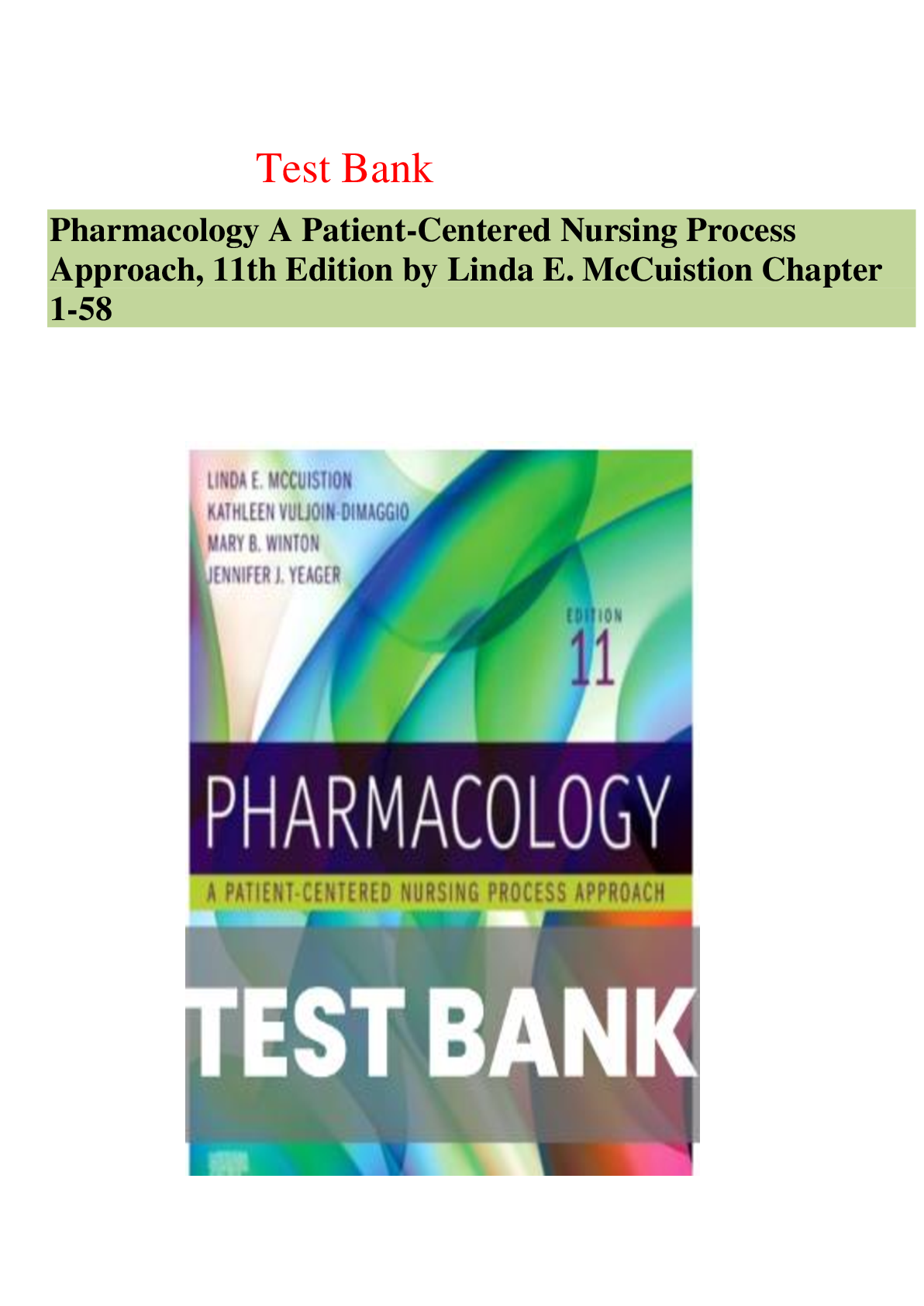
Buy this document to get the full access instantly
Instant Download Access after purchase
Add to cartInstant download
Reviews( 0 )
Document information
Connected school, study & course
About the document
Uploaded On
Oct 02, 2023
Number of pages
371
Written in
Additional information
This document has been written for:
Uploaded
Oct 02, 2023
Downloads
0
Views
20

